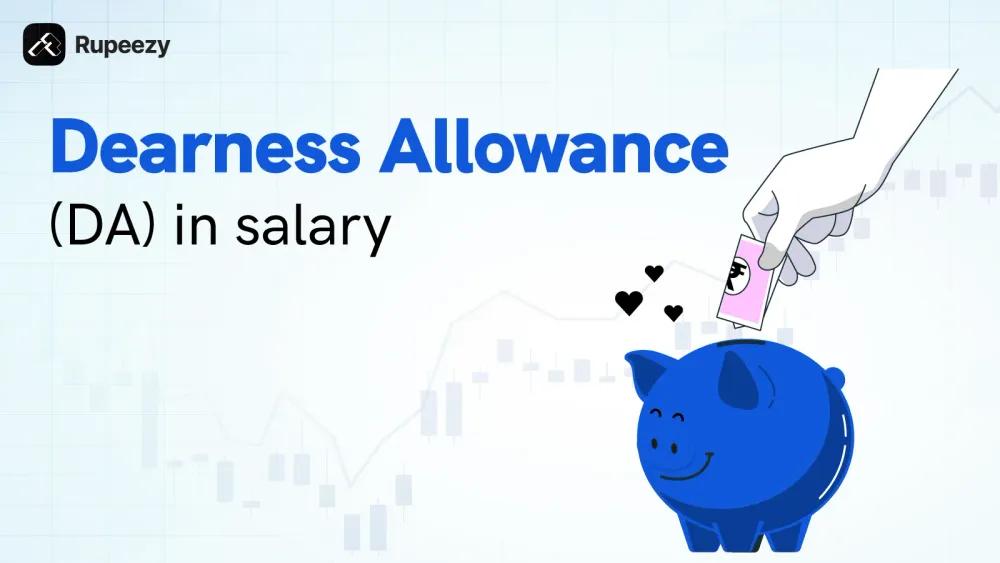Dearness Allowance in Salary: Meaning, Types, Calculation


00:00 / 00:00
DA is a term you must have come across often in news when the government announces DA rate revision every year. Dearness Allowance is simply a component of the salary earned by central government employees. DA is calculated and adjusted to account for inflation in the economy which reduces the real value and purchasing power of money. Since the entire salary cannot be revised to account for the impact of inflation on earnings, DA is the perk designed to accommodate this increase in the cost of living.
In this article, we will discuss details of dearness allowance meaning, its types, how it is calculated, and more.
What is DA in Salary?
DA or Dearness Allowance is the component of salary paid by the Indian government to public sector employees and pensioners to accommodate for inflation or ‘dearness’ or an increase in the price of goods and services in the economy. DA is not fixed but a variable component of salary that is changed or adjusted while other components of salary are fixed.
Introduced in India in the early 1940s during World War 2 to combat inflation, DA component was meant to ensure that the wages of the employees were levelled with the rising prices.
DA in salary is calculated as the percentage of basic pay considering the Consumer Price Index (CPI) as per the provisions of the Income Tax Act 1961. It is governed by the Central Government of India and regulated by the Pay Commission.
Types of DA in Salary
1. Industrial Dearness Allowances (IDA)
Applicable to: Industrial dearness allowances apply to public sector employees of the Central Government (including Central Public Sector Enterprises).
Purpose: IDA’s main objective is to provide financial stability for the employees working in the industrial sector to combat rising inflation rates.
Calculation: IDAs are revised quarterly according to the All India Consumer Price Index (AICPI). The IDA’s percentage is revised every quarter based on the changes in the CPI to mirror the trends of inflation.
Importance: It helps industrial workers to maintain their purchase power and cost of living.
2. Variable Dearness Allowances (VDA)
Applicable to: VDA is a dearness allowance for central government employees and state government employees, mainly those coming under the purview of the Minimum Wages Act, of 1948.
Purpose: VDA is extended to workers so that their wages are protected against erosion by inflation. It becomes more important for workers who draw the minimum wage.
Calculation: VDA is revised half-yearly every year, usually in April and October.
It has three components:
Fixed Component: This is the base index that remains fixed for a certain period.
Variable Component: This is the variable component that changes with CPI every month.
Special Allowance: Added from time to time depending upon the notification issued by the appropriate government.
Importance: VDA would ensure that even the smallest of wage earners are also paid an amount that keeps them in pari passu with inflation so that at least minimum quality of livelihood is maintained. VDA changes only as per notification from the government, it remains fixed till revised.
How to Calculate DA in Salary?
Dearness Allowance calculation is done based on the Consumer Price Index and the Industrial average. The calculation of DA is as follows.
The first step in calculating DA is to find the current All India Consumer Price Index (AICPI). You can find it by referring to the government websites.
The second step is to determine the Base Index and calculate the average of AICPI using the Base Index. The below formula helps you understand DA calculations for the central Government and central public sector employees.
For Central Govt Employees:
Dearness Allowance % = ((Average of AICPI(Base Year - 2001 = 100) for the past 12 months - 115.76/115.76)*100
For Central Public Sector Employees:
Dearness Allowance % = (Average of AICPI(Base Year - 2001 = 100) for the past 12 months - 126.33/126.33)*100
Factors Affecting DA (Dearness Allowance)
Dearness Allowance depends upon several crucial factors that stem from economic conditions and changes in the rate of inflation. The major factors that determine DA include:
Consumer Price Index (CPI): It is a measure of the average change in prices of a basket of goods and services commonly consumed by households. It reflects the cost of living and forms the very basis for arriving at the number for calculating DA. In India, the general CPI for estimating DA for government employees is the CPI for Industrial Workers, commonly known as the CPI-IW.
Inflation Rate: DA is directly tagged to the rate of inflation. As inflation rises, so does the DA percentage, to help employees cope with the rise in the cost of living. Generally speaking, a higher rate of inflation leads to a higher DA to help maintain the employees' purchasing power.
Government Policies: Fiscal and monetary policies of the government can be an influencing factor affecting inflation and, thereby, the DA rates. Wage revision decisions, decisions on cost-of-living adjustments, and reforms in the economic system also affect the computation and revision of DA.
Economic Conditions: Economic conditions, such as growth rate, employment rate, market conditions, etc., influence inflation and, hence, the DA. Economic stability and instability could lead to a correction in DA towards changes in living costs.
Base Year for CPI Calculation: The base year considered for computing the CPI would, therefore, affect the DA. The periodic revision of the base year ensures that the current structure of consumption is factored into the series of CPI thereby influencing the adjustment in DA.
How is DA Different from Other Allowances?
Dearness Allowance varies from other types of allowances in many aspects, mainly in terms of purpose, calculation, and application. How DA differs from some of the other common allowances is explained below.
1. Purpose:
Dearness Allowance: DA is mainly paid to an employee to compensate for the loss of purchasing power due to inflation. It is essentially aimed at helping employees meet the increasing cost of living.
Other Allowances: Other allowances such as HRA, Transport Allowance, Special Allowances, and Medical or Travel Allowances cover specific expenses for housing, commute, or other expenditures.
2. Calculation Method:
Dearness Allowance: It is a percentage of the basic salary and revised periodically with the variation in the rate of the Consumer Price Index. The percentage is adjusted with the rate of inflation.
Other Allowances: Most other allowances are either a fixed amount or a percentage of the basic salary, but they are not directly linked to inflation.
3. Frequency of Revision:
Dearness Allowance (DA): DA normally gets revised twice a year keeping the inflation trends in perspective.
Other Allowances: Other allowances are changed less frequently and may occur only at the time of major pay revisions or changes in employment conditions.
4. Tax Implications:
Dearness Allowance: DA is fully taxable as salary. However, a portion of DA can be exempted from tax while forming part of retirement benefits under certain conditions.
Other Allowances: Other allowances are taxed under different heads of income. For example, HRA is partly exempt, to the extent certain conditions are met, while an allowance like special or transport allowance may be fully or partially chargeable to tax.
5. Applicability:
Dearness Allowance: DA mainly applies to government employees, public sector employees, and pensioners as well.
Other Allowances: Other allowances relate to a larger section of personnel, even extending to private sector employment, and are normally part of the general compensation package.
6. Inflation Related
Dearness Allowance: DA is directly linked to inflation and, as such, DA is an allowance whose rate of value changes with the change in times.
Other Allowances: Normally, other allowances have no linkage to inflation and, therefore, the quantum of such allowances remains the same over a period of time, unless changed by the employer.
Latest Changes in DA (Dearness Allowance)
Dearness allowances are calculated based on the percentage of basic pay. With effect from January 2024, the dearness allowance rate is 50% of the basic salary. Before that, it was 46% and has risen by 4%. The revised DA rate is also applicable to pensioners.
Here’s an example of DA calculation.
Suppose your monthly salary is Rs 50,000 and your basic pay is Rs. 30,000. Dearness Allowance at 50% of salary is Rs. 25,000.
Total Salary: Rs. 50,000
Basic Pay: Rs. 30,000
DA: Rs. 25,000
Suppose there is a 3% DA revision.
DA Hike = 3% of DA = 3% of Rs. 25,000 = Rs. 750
Total DA = Rs 25,000 + Rs. 750 = Rs. 25,750
DA under Income Tax
DA is fully taxable for salaried employees. It is included in the total taxable income and subject to tax as per applicable income tax slab rates. However, if you are provided with unfurnished, rent-free accommodation by your employer, the DA may be included as part of your salary while calculating retirement benefits, but only if all other income tax conditions are met. DAs are listed separately when filing income returns to ensure it is correctly accounted for in your tax calculations.
DA vs. HRA
Feature | Dearness Allowance(DA) | House Rent Allowance (HRA) |
Purpose | Offset inflation | Cover rental expenses |
Calculation Basis | Percentage of basic salary | Percentage of basic salary |
Taxability | Fully taxable | Partially exempt from tax |
Linked to inflation | Yes, adjusted periodically | No direct link |
Application | Government and some private sector | Employees in rented accommodations |
Role in Retirement Benefits | Can be included in retirement salary | Not included |
DA for Employees of Different Sectors
Dearness Allowance for Central Government Employees: These employees receive DA revised every six months in January and July every year, with DA being calculated based on the CPI. It constitutes a major portion of an employee's salary.
Dearness Allowance for State Government Employees: The DA rates differ from state to state for its employees, though generally, the state governments declare it in successive years, normally in succession with the central government, but with some differences in the percentage and time factor.
Dearness Allowance for Public Sector Undertakings: In Public Sector Undertakings, employees have their DA revised quarterly in the form of Industrial Dearness Allowance which is calculated based on the All India Consumer Price Index.
Dearness Allowance for Bank Employees: The DA for bank employees is also revised quarterly, keeping in view the AICPI, and it is an essential part of their remuneration.
Dearness Allowance for Employees in the Private Sector: DA is less pervasive and non-standard in its applicability; when it does, it usually features as part of the whole salary package, with variations depending on company policies.
Dearness Allowance for Pensioners: In case of any new pension structure announced for public sector retirees, the pension gets revised. With DA hike, the revised pension includes a DA increase for regular and family pension.
Conclusion
Wrapping it up, DA is considered important because being an adjustment of their salaries helps employees overcome inflation. In particular, for government employees, it means maintaining purchasing power. As an element that changes periodically, the values of DA are kept updated in tune with contemporary prevailing economic conditions. Keep browsing our blogs for more information on many such interesting topics.
At Rupeezy, we believe in keeping our clients updated on all market trends and changes, while remaining your trusted stockbroking partner for smarter financial decisions and secure future investments.
FAQs
1. What is dearness allowance in private companies?
DA is less common in private companies as compared to the government sector. In the case it is part of private sector employee’s compensation, it serves the same purpose of compensating for inflation, but, it usually forms a part of the overall salary package or special allowances instead of being an independent component of salary. This type of DA in a private company is not based on any uniformity but follows the policy of the company concerned.
2. What is the current rate of dearness allowance for bank employees and how does it impact their overall salary?
DA for bank staff is revised every quarter in line with the All-India Consumer Price Index (AICPI) and accounts for a certain percentage of their basic pay, ensuring full compensation against erosion in the purchasing power of money, which influences the salary structure.
Check Out These Related Articles |
The content on this blog is for educational purposes only and should not be considered investment advice. While we strive for accuracy, some information may contain errors or delays in updates.
Mentions of stocks or investment products are solely for informational purposes and do not constitute recommendations. Investors should conduct their own research before making any decisions.
Investing in financial markets are subject to market risks, and past performance does not guarantee future results. It is advisable to consult a qualified financial professional, review official documents, and verify information independently before making investment decisions.

All Category










